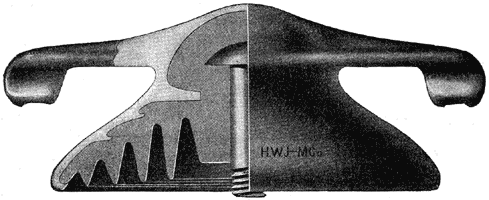[Trade Journal]
Publication: Electrical World and Engineer
New York, NY, United States
vol. 45, no. 1, p. 63, col. 1-2
High Potential Insulators.
Owing to the increasing demand for high-voltage line material, the H. W. Johns-Manville Company has developed a line of insulators much heavier and stronger throughout than its standard line. The high-potential round-top insulator (Fig. 1), has four petticoats giving large surface insulation and is well protected by a malleable-iron shell, so that the possibility of surface leakage is reduced to a minimum. It was built specially for 1,500 to 2,000 volts for alternating-current trolley service, but owing to the great dielectric strength and large surface insulation, this insulator will prove equally efficient at much larger voltages. The same company has also developed several strain insulators, of which one (Fig. 2) is a combination of two of its large "Giant" strain insulators coupled. The coupling is covered with moulded mica insulation, so that a continuous insulating surface is provided from eye to eye of the insulator approximating 8 1/2 in. in length. This insulator is intended for strain work where the potential does not exceed 2,000 volts, but owing to the large insulating surface it may be used on higher voltages. Still another large type recently placed on the market is a strain insulator which has one inch of solid sheet mica through the center of the strain, insulating the metal parts from each other, and is built to stand a working pressure of 5,000 volts. This insulator has approximately 10 1/2 in. insulating surface from eye to eye, and as in the case of the above insulators, could undoubtedly be used on higher voltages.
 |
| Fig. 1. — Round Top Insulator. |
 |
| Fig. 2. — Double Strain Insulator. |
